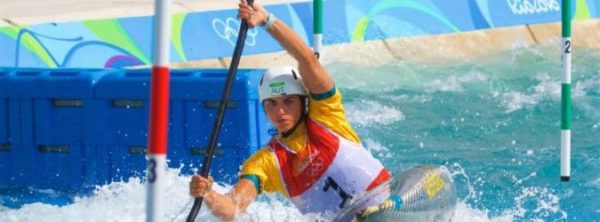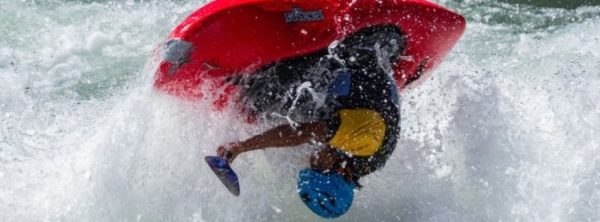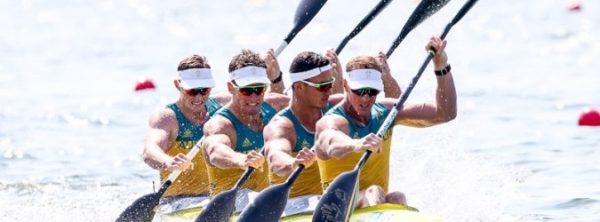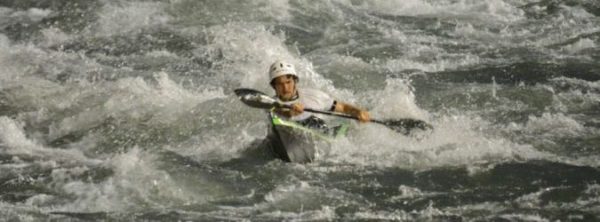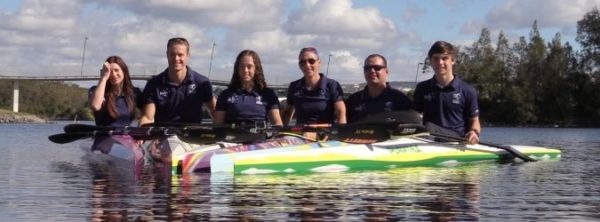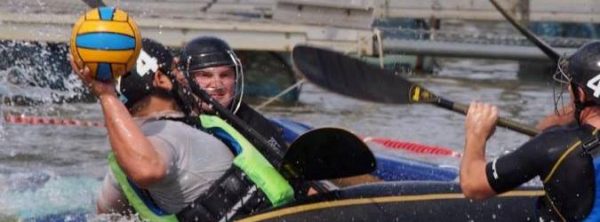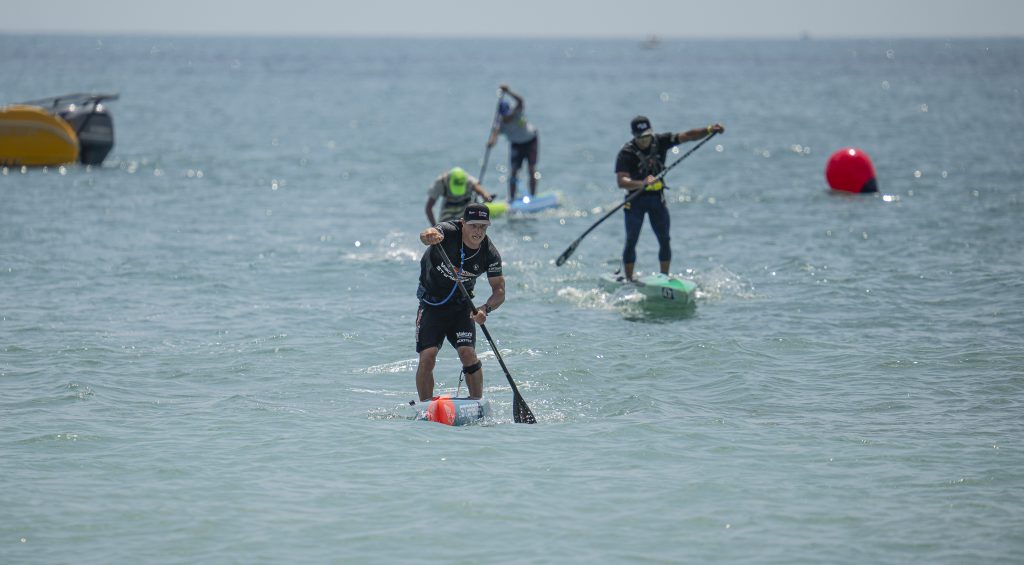RULE 1
WATCH THE BALL
The goalkeeper must watch the ball for 100% of the duration of the game even when the ball is at the other end of the playing area. Use your peripheral vision to call defensive plays to your team mates and for your own anticipation of a bad pass to an opposition player on a fast break.
When a player is baulking before shooting, ensure your concentration is on the ball and not the arm or face of the player.
RULE 2
MAINTAIN A GOOD POSITION RELATIVE TO THE GOAL
Be aware of your body position relative to the goal at all times.
Good positioning is achieved in the following ways:
1) Check the goal frame above you.
2) When warming up prior to the start of the game check the relative position of the other goal and this can be used as a guide for your positioning. Also observe your positioning in relation to any lines or marks on the bottom of the pool which may also help.
3) Checking the angles:
a) Place yourself, or at least your paddle, between the shooter and the centre of the goal.
b) Stop the ball in the AB plane, perpendicular to the line drawn between the shooter and the centre point of the goal.
c) Consider that percentages have proven that, if the player is coming in from the side, they will shoot towards the near corner.
4) Make the shooter commit himself before you do. Try not to move on the players baulk. Move the paddle sideways along AB rather than closer or farther away from the shooter.
RULE 3
PADDLE POSITIONING
There are three basic positions that a goalkeeper should adopt.
1) Field player position:
This position is the same as any other player on the playing area and is used when the chance of a shot is minimal. The goalkeeper should be relaxed but concentrating and be available to intercept bad passes or anticipate a bad pass and paddle out to the ball and and take quick free throws for fast break opportunities.
2) Vertical Paddle:
Once the opposing team has advanced the ball past half way, the defending goalkeeper should begin to place their paddle in a vertical position. The paddle may be rested on the sprayskirt with the top hand placed on the shaft and the bottom hand in the water, sculling to maintain position.
3) Vertical Alert Paddle:
As the ball comes in closer, the goalkeeper brings the bottom hand on to the blade of the paddle and raises the paddle to cover the goal frame. The paddle may be moved back towards the goal frame to confirm your position and then moved in to you own comfortable ready position.
RULE 4
HAND POSITIONING ON THE PADDLE.
A variety of methods is used by many successful goalkeepers and you should choose from any of these and then modify to suit your own personal style.
Blade orientation:
1) Power face to shooter. This tends to give more control of the ball and makes it easier to drop the ball in to your hands from a weak shot.
2) Power face to goal. An alternative to method one and generally depends on the grip preferred by the bottom hand. Less ball control is generally a negative aspect of this style.
Bottom Hand:
1) Bottom edge grip. The bottom blade is positioned edge on to the goalie and is cupped in the bottom hand. This style give maximum height advantage but lacks some power unless the hand grip is very strong.
2) Bottom corner grip. The hand is placed on the corner furthest away from the goal keeper and is a good compromise of height and power. Power is gained by pulling the bottom hand towards the body as the top hand is moving towards the shot.
3) Vertical edge grip. The bottom hand is placed on the far vertical edge of the paddle near to the bottom corner. This gives maximum bottom hand power but limits the reach of the paddle.
Top Hand:
1) Forehand grip (Palm to goalkeeper): This is the most popular style as it allows more height to be attained because the wrist can be straightened.
2) Backhand grip (Palm to shooter): This style has more power but is restricted by the cocked wrist and may be a disadvantage to short players.
Hand Orientation:
The choice of left or right hand as the bottom hand will depend on personal preference and experience. Try both and develop your own unique style. For players with unstable shoulder from past injuries such as dislocations etc. will find it beneficial to have the injured arm as the bottom arm to prevent hyperextension of the shoulder joint.
Addendum: Consider the following.
When a player is coming in on the goalkeepers right, greater reach (height) will be obtained if the left hand is the top hand. The reverse is true from the opposite side. It may be useful to be able to defend the goal in either hand orientation to allow the goalkeeper to switch depending on the side that the shooter is approaching. Straight on shots will obviously be able to be handled by the most comfortable hand orientation
More power is also available to move the paddle to the near corner with the push of the top hand and a pull of the bottom hand.
RULE 5
PASSING
Always pass the ball confidently, and to the right player.
1) Don”t pass the ball unless you are 100% sure it will find its mark.
2) Always pass to advantage ie. either ensure that your player is between the opponent and the ball or that they can paddle onto the ball to allow the smooth continuation of a break.
3) As a general rule try to pass to the side that is you strongest throwing arm after first scanning the entire pool to ensure an advantage is not available to the left.
4) Never pass through a paddle. Pass to the “safe” side. the opposite side to where the opponent is tackling you if you have the option.
5) Pass early ( when the opponent is at least one boat length away) to give the opponent no chance of an intercept.
6) Use double handed chest passes when you are near your own goal line to avoid giving a corner to the opposition.
7) If you have to throw a baseball style pass then paddle forward with your free hand to gain some room to work in thus avoiding a corner.
8) Look for outlet passes that are less than 6 metres rather than attempting the 20m fast break pass. It is safer to clear the goal are to the side of the pool to avoid any fast knockdown of your long passes.
RULE 6
ABSORBING AND CONTROLLING THE BALL
A shot blocked back into the field of play is dangerous as it may give the attacking team an opportunity of a rebound. Rather, the shot should be absorbed by the paddle and the arms to control the ball and allow the rebound to drop into your hands. This has the added advantage of allowing for a fast break while the opposition is still in a very attacking position and unable to turn and meet the fast breaking defenders moving into offence.
The arms should be firm but relaxed to absorb the power in the shot. The goalkeeper should be quick to reach for any rebounds that land on the water in front of you. The goalkeeper may be able to drag the ball into their own hands, push it to a team mates hands, take it over the goal line for a corner, or jab it off the incoming line of the attacker to make it difficult to pick up and shoot.
RULE 7
RECOVER PADDLE POSITION QUICKLY
After making a save assume the vertical paddle alert position as soon as possible to be ready for a rebounded shot. Be alert and ready at all times.
RULE 8
LOB SHOTS
1) Ensure your hands are in the correct orientation to gain maximum height and change the bottom hand grip to a finger tip grip.
2) Do not take your eye off the ball.
3) Attempt to jab the ball as it passes over head rather than attempting to catch the ball with the paddle. The fingertip grip does not have much lateral strength and the ball may roll off the blade and into the goal if you attempt to block the ball rather than jab it over the goal.
4) If you miss the ball continue to watch the ball as it may rebound gently off the goal frame and you can scoop the ball into your hands with the paddle or over the goal line for a corner.
RULE 9
FAST BREAK SHOTS
During the game a player may get a fast break and be one on one with the goal keeper.
1) If the ball is about to be passed to the player on the fast break:
a) The goalie should anticipate a bad pass and take a stroke towards the ball.
b) If the pass is indeed a bad one then the goalie should continue paddling out and and pressure the ball and maybe force a turn over or poor shot.
2) If the player has the ball and is dribbling on a fast break:
a) move out an extra 20cm from your original position. This may upset the attackers timing of the shot.
b) Attempt to fake a full commitment which will make the opponent hurry his shot.
RULE 10
DEFENSIVE AWARENESS
1) Know all the defensive styles used such as press, 4-1, 2-2-1, 1-3-1 and assist your team mates to perform these styles of defence.
2) Tell your defenders which player you want covered eg. Their strongest shooter.
3) Warn your team mates of developing moves by the opposition such as danger on the right, defence too close to the goalie.
4) Keep your defender well clear of your kayak to avoid being moved inadvertently. A full boat length is a good starting position for your defence.
RULE 11
OFFENSIVE AWARENESS
1) When your team gains possession break into offence.
2) Be confident in your basic skills to be part of the general play.
3) Know the different moves that your coach wants to be played.
4) Ensure your team mates know to cover your goal if you drive to the opponents goal.
5) Return quickly after your team has scored to cover your own goal to avoid a quick goal by the opposition before you are ready. Have an understanding with your team mates that they must cover the goal if you are unable to return quick enough.
RULE 12
PRACTICE
1) Make sure that you do goal keeper specific training wherever possible.
2) Ask your coach to devise drills that will test your skill that will be needed in a game
a) 5 mins lobs
b) 5 minutes long shots
c) 5 mins angle shots
d) 5 mins fast break shots. etc…..






